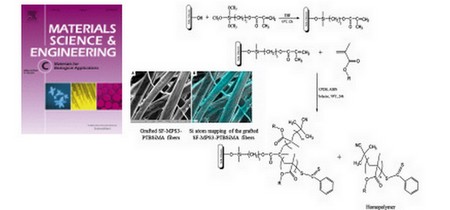

In this study, silk fibroin surface containing hydroxyl and aminogroups was firstly modified using a polymerizable coupling agent 3-(trimethoxysilyl) propyl methacrylate (MPS), in order to induce vinyl groups onto the fiber surface. The reversible addition–fragmentation chain transfer (RAFT)-mediated polymerization of methyl methacrylate (MMA) and tributylsilyl methacrylate (TBSiMA) through the immobilized vinyl bond on the silk fibroin surface in the presence of 2-cyanoprop-2-yl dithiobenzoate (CPDB) as chain-transfer agent and 2,2′-azobis(isobutyronitrile) (AIBN) as initiator was conducted in toluene solution at 70°C for 24 h. The structure and properties of the modified fiber were characterized by Fourier Transform Infrared Spectroscopy, 13C, 29Si Nuclear Magnetic Resonance (NMR) spectroscopy, thermogravimetric analysis (TGA), scanning electron microscopy (SEM) and energy dispersive spectroscopy (EDS), confirming the presence of the coupling molecule and the methacrylate groups onto the silk fibroin fiber surface. Molecular weight distributions were assessed by triple detection size exclusion chromatography (TD-SEC) in order to verify the livingness of the polymerization.
